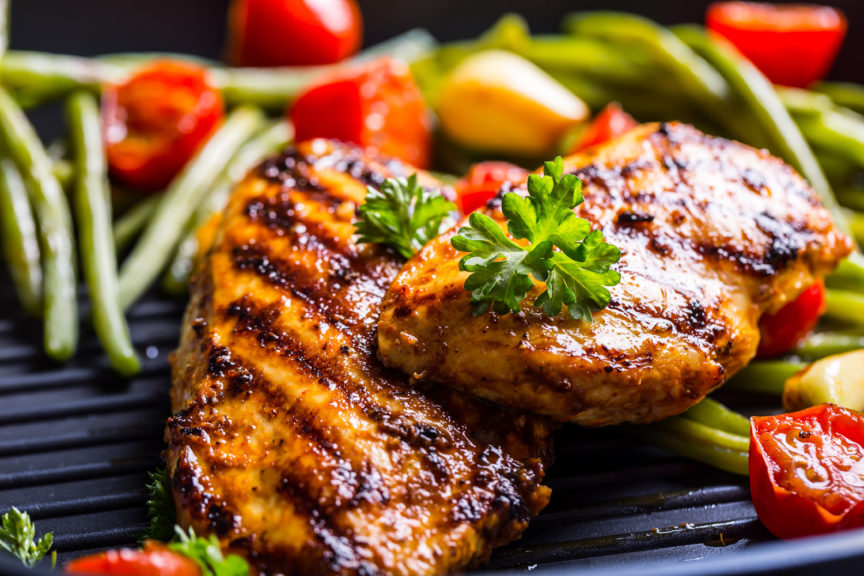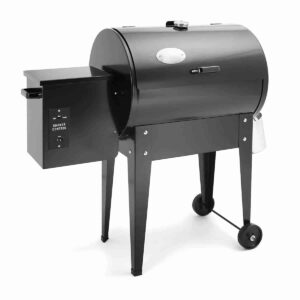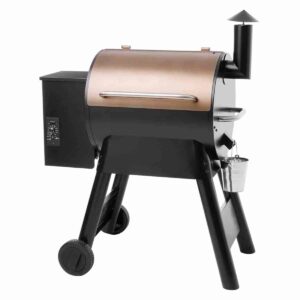If you’ve been grilling for a while, you may have already branched out from cooking hamburgers and hotdogs on your outdoor grill. The next level in your grilling skills can be learning how to cook pork. It’s no secret that pork cooks different from other meats. So, I researched how long it would take someone to cook pork on their grill.
How long does it take to cook pork on the grill? Pork is considered fully cooked when the internal temperature is around 150 degrees, but the cook time can reach almost twenty minutes depending on the thickness and part of the pig.
Cooking pork can be tricky. Overcooked pork can be tougher than a brick. But more importantly, in no way can pork be eaten undercooked. If you decide that this meat is going to be on your dinner menu, make sure you know what you’re doing before you fire up the grill.
How Long Does it Take to Cook Pork on the Grill?
Factors to consider when cooking pork:
- Temperature
- Thickness
- Recipe
- Using an indoor or outdoor grill
The cook time for pork chops depends greatly on the thickness and the recipe. Not all pork chops are cut the same, and they certainly are not all from the same part of the pig.
Naturally, the thicker the cut, the longer the cook time. For pork chops that aren’t super thick, expect to cook your meat on direct high heat for about 7 to 8 minutes on each side. Always check the internal temperature, however, before you put them on a plate.
For thicker cuts, be prepared to keep each side on the grill on a lower heat for at least ten minutes. Grilling super thick pork chops on incredibly high heat can leave the pork burned on the outside with a raw center.
If you are using a slow cooker recipe, your pork chops can cook for several hours. In some recipes, your pork chops can cook at a low temperature overnight. The longer the cooking time, the lower the heat.
If you opt to go this route, make sure you invest in a quality slow cooker smoker. This is not something an average grill can typically do.
Lastly, indoor and outdoor grills cook differently. Indoor grills that have heated plates on both the top and the bottom, can cook both sides of the meat at the same time. This method essentially cuts the cooking time in half. Be sure to still flip the meat at least once, to make sure the heat is evenly distributed.
Aside from pork chops, there are other types of pork you can cook on your grill. This can include pork ribs, pork tenderloin, pork belly and others. The cook times all differ.
Pork tenderloin typically cooks for 12 to 15 minutes on each side. Most cooking websites will tell you to flip the meat every 2 minutes. You should keep your grill surface to at least 450 degrees, without exceeding 500.
Pork ribs take much longer to cook. It’s typically recommended that you set your grill to 200 degrees and cover the lid. The meat will most likely take anywhere from 90 minutes to 2 full hours to cook completely.
Pork belly is another type of pork that cooks on a lower temperature. It’s also one that you need a smoker for. When set to 225 degrees, it takes about 6 hours to cook. Pork belly is longest cooking meat you can make.
What Temperature Should Pork Be on the Grill?
Unlike pork butt and pork shoulder, which roast up nice and juicy, pork tenderloin has a reputation for being dry. That’s because it’s such a lean cut of meat.
Cooking it can, therefore, be challenging. And grilling, with the direct heat blasting away at the meat, can be especially difficult. It’s not impossible though.
Just like coffee orders at Starbucks, everyone likes their food prepared a certain way, and you can be the one to give it to them. Many beginning grillers make the mistake of checking the doneness of their meats while they’re still on the grill.
Cutting into your meat to check its color releases the juices that make your food flavorful. So, put that steak knife away until your meat is fully rested and ready to be eaten!
Correct Temperatures For Grilling Pork:
- 145°F
- 63°C
- 3 minutes of rest after removal from the grill
When it comes to grilling ham, pork roasts, and pork chops, the USDA recommends sticking to medium doneness and up. 145°F is the magic number for pork, plus 3 minutes of rest after it comes off the grill.
Just like with beef, you should insert a digital meat thermometer half an inch into the thickest part of the cut to get an accurate read on temp.
Grilling a thick cut of meat over the high heat of a grill the entire time will result in a charred exterior, overcooked meat just underneath, and an undercooked center. The solution is a two-stage cooking method, as follows:
The initial sear over high heat gives the meat its colorful, flavorful crisp exterior. At high temperatures, a few minutes is all it takes for the Maillard reaction to do its work.
Moving the thick pork chops to the indirect heat side of the grill allows the rest of the meat to more slowly come to its pull temperature. The result is meat with a seared exterior and an interior with edge-to-edge juicy doneness.
Many people swear that bone-in steaks and chops are juicier and more flavorful than those that are boneless.
Bones are a poor conductor of heat. Bones do not conduct heat very well, causing the meat around the bones to cook more slowly.
Bones provide insulation for the meat next to it. The meat next to the bone would be left at about 120°F the muscle fibers begin to denature, making the meat firmer.
The fat in the meat begins to render at about 130°F. Once the temperature of muscle fibers reaches 150°F, it shrinks, becomes even more firm, and starts rapidly expelling moisture.
It’s important for the pork to reach 145°F (63°C) and no higher to develop the proper texture with the muscle fibers and fat and to be safe to eat.
Stay away from the higher temperature ranges that will leave the pork irreversibly tough and dry and exposed if the pork chop was boneless. Since the bone insulates it from the air, it can retain more moisture rather than losing it to evaporation.
Fat deposits next to the bone. Fat contributes to both flavor and juiciness in cooked meat. The fat deposits next to the bone are gone in boneless meat, sacrificing flavor.
How to Know When Pork is Done on the Grill
It may be known as a white meat, but, in actual fact, pork is a red meat, and all the same rules apply to it as beef and lamb. To get juicy pork that isn’t dry or rubbery you need to ensure you give it time to rest, so that the juices can settle and will stay in the meat.
And, although it may seem contrary to everything you’ve ever been told, it’s actually perfectly okay for your cooked pork to have a hint of pink. So treat it with care, and don’t overcook it to ensure your meat is at its best, every time.
How To Know When Pork Is Done On The Grill:
- Using a meat thermometer
- Performing the finger test
The easiest way to tell if your pork shoulder is perfectly roasted is to use an oven thermometer. The pork will be perfectly cooked when it has an internal temperature of 165 degrees in the thickest part of the cut.
To be safe, you should definitely keep cooking it until the internal temperature reaches at least 160 degrees. Cooked for that long at such a low temperature, you definitely won’t be ending up with tough meat, if it’s really taking a long time, feel free to raise the oven’s temperature up by 50 degrees or so and checking in every 30 minutes.
Pork shoulder is at its best when it’s cooked to quite a high internal temperature – upwards of 170. Many people usually cook it to about 180 or 185, or until the meat pulls apart easily when you poke at it with a fork. When you pick it all apart, the shoulder bone should come out clean, without a scrap of remaining meat.
Remember to ensure your thermometer doesn’t touch the bone, or you risk getting an incorrect reading and undercooking your pork. Allow the roast to rest for at least 15 minutes before carving.
There’s a high enough fat content in the shoulder that it should stay plenty juicy. If you’re worried about it drying out, occasionally ladling the pan juices over the meat should keep it moist until it’s reached the ideal temperature.
Similar to other roasts, when cooking roast pork loin, the best way to ensure your meat is perfectly cooked is to rely on your meat thermometer.
If you don’t have a thermometer, there are still ways to see if your pork is cooked completely.
There are two basic methods to test for how done your meat is while you are cooking it: using a meat thermometer, or pressing on the meat with your fingertips.
The problem with the meat thermometer approach is that when you poke a hole into the meat with a thermometer, it can let juices escape, juices that you would rather have stay in the meat. For this reason, most experienced cooks rely on a “finger test” method.
This is one of those things that gets easier with practice. The next time you cook a steak, even if you are still planning to rely on a meat thermometer, press on the meat here and there while it cooks, and compare the feeling of the meat with the following finger test.
With practice, you will become more confident.The finger test, on the other hand, can be done in just a few steps.
Open the palm of your hand. Relax the hand. Take the index finger of your other hand and push on the fleshy area between the thumb and the base of the palm. Make sure your hand is relaxed.
Now gently press the tip of your pinky and your thumb together. Feel the fleshy area below the thumb. It should feel quite firm. This is what well done meat feels like when you press on it.
Press the tip of your ring finger and your thumb together. The flesh beneath the thumb should give a little more. This is what meat cooked to a medium doneness feels like.
Gently press the tip of your middle finger to the tip of your thumb. This is medium rare.
Press the tip of your index finger to the tip of your thumb. The fleshy area below the thumb should give quite a bit. This is what meat cooked to rare feels like. Open up your palm again and compare raw to rare.
How to Know When Pork is Done on the Grill
It may be known as a white meat, but, in actual fact, pork is a red meat, and all the same rules apply to it as beef and lamb. To get juicy pork that isn’t dry or rubbery you need to ensure you give it time to rest, so that the juices can settle and will stay in the meat.
And, although it may seem contrary to everything you’ve ever been told, it’s actually perfectly okay for your cooked pork to have a hint of pink. So treat it with care, and don’t overcook it to ensure your meat is at its best, every time.
How To Know When Pork Is Done On The Grill:
- Using a meat thermometer
- Performing the finger test
The easiest way to tell if your pork shoulder is perfectly roasted is to use an oven thermometer. The pork will be perfectly cooked when it has an internal temperature of 165 degrees in the thickest part of the cut.
To be safe, you should definitely keep cooking it until the internal temperature reaches at least 160 degrees. Cooked for that long at such a low temperature, you definitely won’t be ending up with tough meat, if it’s really taking a long time, feel free to raise the oven’s temperature up by 50 degrees or so and checking in every 30 minutes.
Pork shoulder is at its best when it’s cooked to quite a high internal temperature – upwards of 170. Many people usually cook it to about 180 or 185, or until the meat pulls apart easily when you poke at it with a fork. When you pick it all apart, the shoulder bone should come out clean, without a scrap of remaining meat.
Remember to ensure your thermometer doesn’t touch the bone, or you risk getting an incorrect reading and undercooking your pork. Allow the roast to rest for at least 15 minutes before carving.
There’s a high enough fat content in the shoulder that it should stay plenty juicy. If you’re worried about it drying out, occasionally ladling the pan juices over the meat should keep it moist until it’s reached the ideal temperature.
Similar to other roasts, when cooking roast pork loin, the best way to ensure your meat is perfectly cooked is to rely on your meat thermometer.
If you don’t have a thermometer, there are still ways to see if your pork is cooked completely.
There are two basic methods to test for how done your meat is while you are cooking it: using a meat thermometer, or pressing on the meat with your fingertips.
The problem with the meat thermometer approach is that when you poke a hole into the meat with a thermometer, it can let juices escape, juices that you would rather have stay in the meat. For this reason, most experienced cooks rely on a “finger test” method.
This is one of those things that gets easier with practice. The next time you cook a steak, even if you are still planning to rely on a meat thermometer, press on the meat here and there while it cooks, and compare the feeling of the meat with the following finger test.
With practice, you will become more confident.The finger test, on the other hand, can be done in just a few steps.
Open the palm of your hand. Relax the hand. Take the index finger of your other hand and push on the fleshy area between the thumb and the base of the palm. Make sure your hand is relaxed.
Now gently press the tip of your pinky and your thumb together. Feel the fleshy area below the thumb. It should feel quite firm. This is what well done meat feels like when you press on it.
Press the tip of your ring finger and your thumb together. The flesh beneath the thumb should give a little more. This is what meat cooked to a medium doneness feels like.
Gently press the tip of your middle finger to the tip of your thumb. This is medium rare.
Press the tip of your index finger to the tip of your thumb. The fleshy area below the thumb should give quite a bit. This is what meat cooked to rare feels like. Open up your palm again and compare raw to rare.
The Best Grilled Pork Recipes
Low-carb greek seasoned grilled pork chops with lemon and oregano are a great dinner idea when the weather gets warm, but you can use a stovetop grill pan and make them any time of year. These tasty pork chops are low-carb, keto, low-glycemic, gluten-free, dairy-free, south beach diet friendly, paleo, and whole 30.
Grilled pork tenderloin fajitas are a quick and easy way to get a summer meal served in under 30 minutes. Marinated pork tenderloin is grilled along with onions and peppers. The pork is sliced then all are served on warm tortillas garnished with fresh avocado and cilantro.
Thick pork chops can be stuffed with a flavorful combination of asparagus, onions and seasonings, and grilled to perfection. These grilled stuffed pork chops are super easy to make.
If you’re looking for a pork chop marinade that’s perfect for grilled pork chops or even baked pork chops, try the marinade recipe from Gimme Some Grilling’s website.
It’s full of flavor, a quick and easy marinade recipe that’s perfect for your family dinner or your summer BBQ parties. You can even use simple marinade recipe on chicken and steak.
Look for pork chops that are all about the same size and thickness, that way the meat will cook at the same rate. Most people look for boneless pork chops that are about 1 inch thick.
You can go thicker or thinner, but just be aware that most pork chop recipes are written with 1 inch thick chops in mind, so you may have to adjust the cooking time.
Here are some great recipes for grilling pork:
- Greek style pork chops
- Grilled pork tenderloin fajitas
- Barbecue pork chops
Delicious Side Dishes for Grilled Pork
Pork roast is a fabulous main dish to serve at any gathering, from holiday celebrations, to weekend dinners with family and friends. When paired with side dishes that complement it perfectly, roast pork is transformed from an everyday protein, into a special, celebratory meal.
The Best Side Dishes For Grilled Pork:
- Mashed potatoes
- Salad
- Apple slaws
- Bean salads
What is a dinner party except an excuse to make and eat mashed, roasted, or creamed potatoes? Sweet potatoes are no exception, but don’t forget that a starchy side can also be creamy cauliflower, baked mac and cheese, or even a lush ladle of buttery grits.
Meaty pork chops feel more like a well-rounded dinner when they are paired with a green vegetable — maybe that’s something cooked like roasted Brussels sprouts or sauteéd spinach, or nothing but a crisp salad. Any of these sides will balance out the plate.
Simple pasta and grain sides also pair well with pork chops. Instead of cooking up just a plain pot of rice, however, try something with a bit more spunk, like an orzo salad filled with roasted veggies, couscous infused with smoked paprika, or barley flecked with sage.
Pork-and-beans is a thing for a reason—embrace it. Fresh cranberry beans are super creamy and delightful, but if you don’t have them on hand or have trouble tracking them down, you can swap them for pinto beans.
Another good side dish for pork can be carrots. You can even throw your carrots on the grill. Another option for your carrots is to cook them with a brown sugar and butter glaze.
Granny smith apple slaw is another great option. Apples pair beautifully with roast pork, and this tasty, tangy slaw with tart-sweet Granny Smith apples is a great way to wake up palates. The lively mayonnaise-based dressing includes cilantro, mustard, lemon juice, caraway seeds, and thyme, for fantastic flavor.
Roasted butternut squash takes on a caramelized sweetness that nicely complements pork’s mild flavor. This vegetable side dish is a snap to fix, with olive oil, sage, salt and pepper, and onions. Toss in a few dried cranberries for extra color and flavor.
Finally, creamy mashed cauliflower is a lower-carb alternative to the mashed potatoes you might serve with pork. Recipes for this includes some potatoes in the mix, plus shredded cheddar cheese, for a side dish that packs all the great flavor and luscious texture you crave, and then some.
Check out our Recent Posts
Z Grills Review
If you’re looking for a grill that will last, Z Grills is the way to go. Z grills are made of the best quality materials...
Read MorePit Boss Pellet Grill Review
Pit Boss is one of many when it comes to manufacturers of wood pellet grills and smokers. If you have spent any amount of time...
Read More10 Fun Benefits of Taking an Online Cooking Class
There’s never been a better time to take an online cooking class. With the continued popularity of online learning, there are more and more exciting...
Read More



